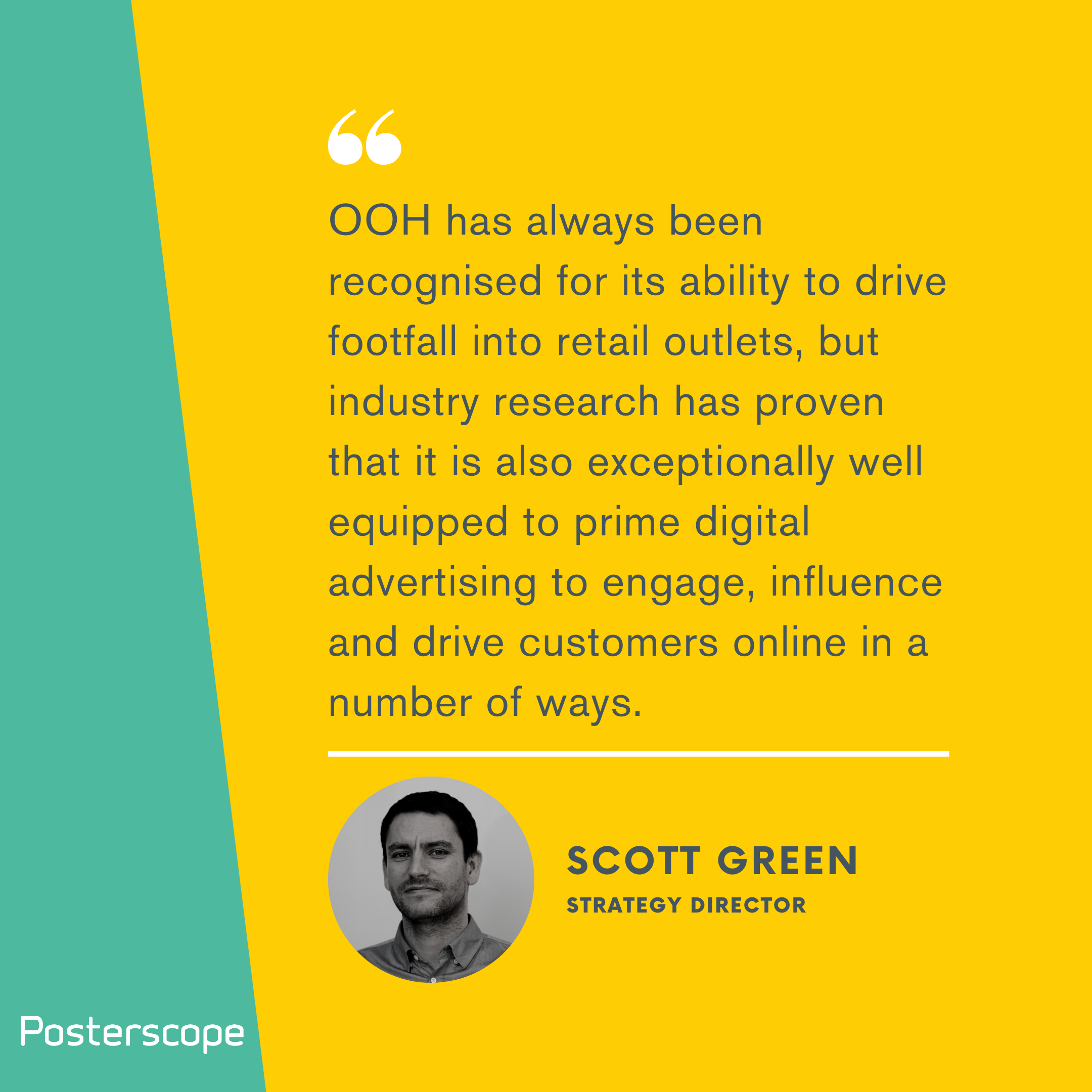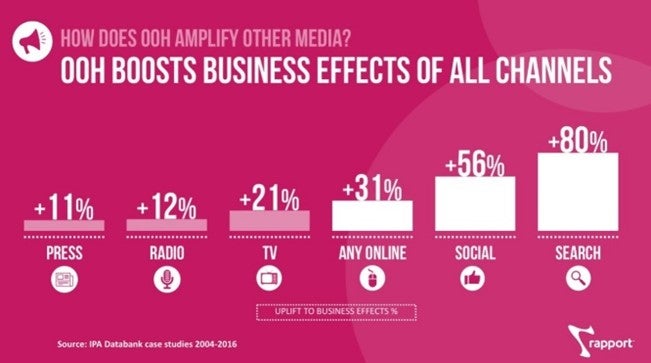
As everyday life remains for many in and around home, the way people are shopping has changed significantly. People are spending more time and money online than ever before and this isn’t about to change, with only 16% of UK consumers saying they intend to return to their old shopping habits (Wunderman Thompson).
Out of home has always been recognised for its ability to drive footfall into retail outlets, but as physical stores have closed many advertisers have overlooked it as an option. However, industry research has proven that out of home is also exceptionally well equipped to prime digital advertising and drive customers online in a number of ways:
1. Tech and data digitise OOH (reach).
Reach is still the key ingredient for driving market share and building brands. Reaching over 90% of the UK, OOH typically drives a 20% increase in business effectiveness when added to the media-mix. (IPA – Marketing Effectiveness in the Digital Era). OOH essentially provides a way for brands to build mass awareness with comparably low CPM’s. A powerful and trusted interaction, OOH nudges consumers into the buying funnel where digital plays an increasingly important role.
Developments in technology and data have effectively digitised OOH’s reach. Mobile data reveals consumers’ movements and digital behaviours, providing a clear view of where, when, and how consumers interact with digital content when outside of their homes.
Using data to plan OOH optimises reach. Brands can effectively target different audiences to influence new and changing patterns in consumer behaviour through location, frequency, and context. And the flexibility and agility of DOOH ultimately sharpens this focus to transform how brands drive saliency through contextual relevance…at scale.
Lenovo used mobile device data to plan their OOH, increasing awareness and consideration by 200% – and growing online searches by 150%.
2. OOH drives consumers online
Retail footfall jumped 40% last year when non-essential retailers reopened, but the average decline in footfall was still -53%, with Shopping Centres hardest hit at -68%, High Streets -58%, and Retail Parks, with wider open spaces and more supermarkets lowest at -34%. (British Retail Consortium Shoppertrak)
This initial spike in footfall dropped off in subsequent weeks and social distancing poses a long-term challenge. A UK study by Dynata for ChannelAdvisor found 40% of customers who returned to the high street found the in-store experience ‘less enjoyable’ than pre-covid times and returned to online shopping.
As brands and retailers invest to transform the shopper experience, and meet the surge in online buying, understanding how to reach and drive consumes to sites, apps and stores is fundamental for growth across all categories.
Recent research reinforces the effectiveness of OOH in the digital media ecosystem. Digging deeper into the IPA Databanks we can draw a direct connection between OOH and the performance of digital channels, with OOH amplifying the effectiveness of Search and Social. (Rapport/IPA – Standing on the Shoulders of Giants).

Nielsen also found that OOH campaigns boost online search and social media activity more than other traditional media and even online banner ads. Online activations generated by OOH advertising indexes at nearly four times the expected rate given its relative ad spend – which is why big tech and digital companies spend significantly in OOH.
3. OOH is best placed to prime digital channels
In addition to OOH fast being acknowledged as the best primer for all things mobile, and social, digital companies have repeatedly relied on OOH to broaden their appeal, drive new behaviours, and build their brands in the public domain as our lives increasingly migrate online with the ongoing adoption of smart devices. Google’s voice search campaign is memorable for using OOH’s real-world context of location very effectively and driving a 70% increase in search.
More recently we’ve seen Shop Direct, the UK’s largest digital retailer, repeatedly investing in OOH for Very.co.uk as ‘it gives them a shop window on the High Street’, especially during the busiest sales periods of the year, such as Black Friday and Christmas. Smarter use of DOOH with data and dynamic creative drives real-time demand and has delivered a 100% ROI YOY.
4. Omnichannel – OOH, Social & Mobile reach, engage and influence
In today’s smartphone infiltrated world, the way people consume media is constantly changing, and as mobile and digital media become more saturated, OOH can intercept consumers. Using smart data-led planning and buying, OOH can cut-through the noise, earning consumers attention to seek out relevant brands through mobile.
IPA’s 2019 Touchpoints Report highlighted the growing relationship between OOH, Social and Mobile to reaching audiences, in particular the highly valued 16-34yr olds, who consume 50% of their media through mobile devices. OOH’s broad reach and high consumption remains constant across all demographics with only Social Media on a par for reaching 16-34s indicating how the omnichannel approach to media communications will inevitably shift.
OOH has always been a powerful creative experience. It can be bold, provocative, surprising, or delightful, driving consumers online to share experiences or show support, to obtain information, products, or services right there and then, in that very moment. Campaigns like those from Trainline, which used an AR billboard to show live train times when you held up your phone, and Walkers “Tweet to Eat” campaign that turned bus shelters into tweet-activated vending machines provide a glimpse of OOH’s potential as consumer behaviour changes and brands seek to merge the offline with online experience.

5. OOH is at the heart of the change to Mobility
OOH is at the heart of mobility. There’s a natural synergy between the OOH and mobile experience, with both steeped in location. Unlike other media it can’t be skipped, scrolled past, or blocked. It’s hard to ignore. Which is why OOH can affect real behavioural change in ways that other, more passive media cannot.
And as the path to purchase becomes shorter and more frictionless than ever before, holistically combining OOH and mobile can help brands focus on business KPIs – whether that’s sales, engagement or brand building – and optimise the media mix to deliver outstanding results.
Outsmart demonstrated an average uplift of 38% in consumer smartphone brand actions after seeing OOH, with 66% of these brand actions directly with the brand (Outperform 2016). Continued developments in technology and data not only expand OOH’s creative potential to bring campaigns to life, but they will also drive the potential for consumer experiences and interactions with brands at scale.
Brands have consistently sought to leverage mobile as part of their OOH campaigns, to bridge their physical and digital efforts, connecting consumers using interactive QR codes, NFC capabilities and Augmented Reality. KFC famously used Snapchat codes on its OOH to engage and entertain youth audiences and we expect a resurgence of touchless technology as a way for brands to safely engage and interact with people.
The roll out of 5G technology will also transform the way we connect. Apple’s launch of the 5G iPhone has accelerated this transformation and our mobility, changing our digital lives and behaviour forever.
A mobility first approach
As Covid-19 has changed consumer behaviour, so it has changed OOH campaigns. Certainly they must become more localised now, and perhaps longer than the typical two weeks to maximise audience reach and frequency. But it doesn’t change how brands should plan and buy OOH media. Smart, data-led planning leverages OOH’s reach. As our worlds become smaller and more localised and we move online, many might recommend brands take a Mobile First approach – but it’s actually Mobility First.
Mobility reflects who the consumer is, their lifestyle, their choices, their mindset…the delivery of information on the go that makes things easy for consumers to interact. And location data is the key output that reflects mobility and informs the consumer journey in a whole new way … nudging consumers into the buying funnel.
And OOH is at the heart of mobility.

